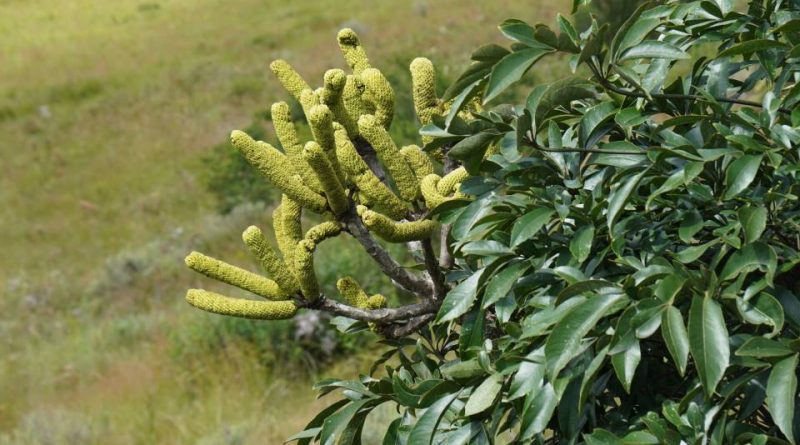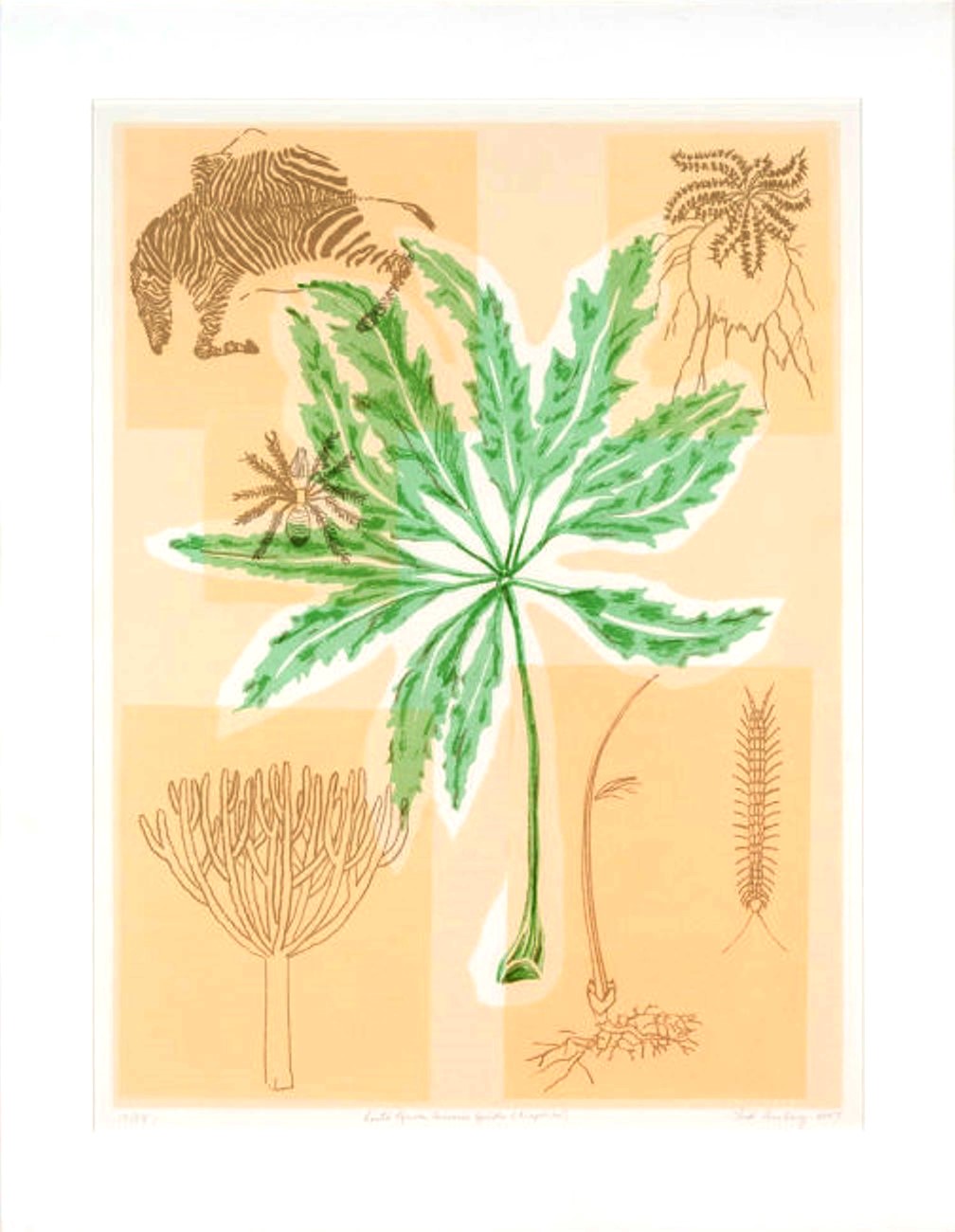Cussonia spicata
Cussonia spicata
The spiked cabbage tree or lowveld cabbage tree, common cabbage tree (Cussonia spicata Thunb., 1780) is an arboreal species belonging to the Araliaceae family.
Systematic –
From a systematic point of view it belongs to:
Eukaryota domain,
Kingdom Plantae,
Subkingdom Tracheobionta,
Spermatophyta Superdivision,
Division Magnoliophyta,
Class Magnoliopsida,
Subclass Rosidae,
Order Apiales,
Araliaceae family,
Subfamily Aralioideae,
Genus Cussonia,
Species C. spicata.
The terms are synonymous:
– Cussonia boivinii Drake;
– Cussonia calophylla Miq.;
– Cussonia kraussii Hochst.;
– Cussonia quercifolia Hort.Cels;
– Cussonia quercifolia Hort.Cels ex Colla;
– Cussonia spicata subsp. streyi Reyneke;
– Cussonia spicata subsp. triptera (Colla) Reyneke;
– Cussonia triptera Colla.
Etymology –
The term Cussonia is in honor of the French botanist Pierre Cusson (1727-1783) specialized in Umbelliferae.
The specific epithet spicata comes from the Latin “spicatus”, that is, with ears, in reference to the inflorescences.
Geographic Distribution and Habitat –
Cussonia spicata is a plant native to Africa, present in an area that includes: Botswana, Kenya, Malawi, Mozambique, the Democratic Republic of Congo, South Africa, Sudan, Swaziland, Tanzania, Uganda, Zambia and Zimbabwe and the Comoros Islands.
In these areas it grows in open rocky areas, savannahs and on the edges of forests, mountain grasslands and among ferns, up to 2,600 m altitude in Tanzania.
Description –
Cussonia spicata is an evergreen or semi-deciduous tree, very branched in old specimens, up to about 15 m tall, with the foliage concentrated in dense globes at the apex of the branches.
The roots can be large, swollen and succulent.
The bark is grayish in the young parts and yellowish and deeply fissured in the old ones.
The leaves have a diameter of up to about 70 cm; they are dark green or bluish green in color, on petioles up to 60 cm long; these are palmate-compound with 5-9 lobes up to 30-35 cm long, irregularly pinnate and deeply incised at mid-rib, with leaflets 6-15 cm long and 4 cm wide with generally toothed margins; in the juvenile phase the leaves can be more or less entire.
The inflorescences are in a terminal panicle position; the flowers are greenish-yellow in color gathered in 8-12 compact spikes, up to 20 cm long, in the shape of a candelabra.
The fruits are ovoid in shape, purple in color when ripe, about 6 mm in diameter.
Cultivation –
Cussonia spicata is a tree that is harvested in the wild for local use as a food, medicine and source of wood. It is also used to delimit fields, graves, etc. and for shading and as an ornamental element.
All species of this genus have potentially destructive root systems and should therefore be kept away from any structural element and underground services such as sewer pipes, water pipes and electrical cables.
It is a fast-growing species, very decorative due to the shape of the foliage and leaves, suitable for tropical, subtropical and marginally warm temperate climates, withstanding temperatures up to -3/-4 °C for a short period, to be planted isolated to enhance its characteristics and in any case, as mentioned, away from walls, fences, sewer pipes, etc. having a very aggressive and superficial root system. In pots it should be grown in sandy and draining substrates in a bright position at temperatures which should not fall below 12-14°C; watering must be moderate during the vegetative period and reduced in winter. Due to the stem that can easily take on twisted shapes and the succulent roots, it is a subject appreciated by collectors of caudiciforms and for creating bonsai.
The plant reproduces by seed, which has a short-term germination potential, in which case it flowers from eight years of age, and by cuttings.
Furthermore, plants of this genus generally do not transplant well once established, so the location must be chosen carefully.
Customs and Traditions –
Cussonia spicata is a plant known by various common names, including: “cabbage-tree”, “common cabbage tree”, “lowveld cabbage”, “tree spiked cabbage tree” (English); “kiepersol” (Afrikaans); “cussonia en épis” (French); “arbol de la col” (Spanish); “kohlbaum” (German).
This plant has been used in traditional African medicine and its medicinal properties are being studied.
In traditional African medicine, various properties are attributed to it and are the subject of study. The leaves are used to relieve indigestion; the decoction of the bark and the macerated root are used in the treatment of malaria. A decoction of the root is used to treat fever, venereal diseases and as a diuretic and laxative.
From an ecological point of view, the species is an important source of food for local fauna and the leaves are also used as fodder for livestock; the succulent roots are edible and used in emergency situations and parts of the plant are used in traditional medicine, in particular the bark decoction in the treatment of malaria and the leaves in case of indigestion.
Other uses include agroforestry uses.
The tree is used to mark boundaries and to provide shade.
The wood is white and soft and is used to make temporary stools and doors, troughs, beehives and wheelbarrow wheels.
Preparation Method –
Cussonia spicata is a plant used both for food purposes but also an important plant in traditional African medicine.
In edible use, the large root of young trees is extracted from the ground, peeled and then chewed like cassava to quench hunger and thirst.
In the medicinal field the leaves are used to treat snake bite, malaria and constipation.
A decoction of the bark is used in the treatment of malaria and indigestion in a similar way to tonic water.
A decoction of the root is used to treat fever, venereal diseases, as well as as a diuretic and laxative.
A decoction of root bark is used to treat mental illnesses.
Guido Bissanti
Sources
– Acta Plantarum – Flora of the Italian Regions.
– Wikipedia, the free encyclopedia.
– GBIF, the Global Biodiversity Information Facility.
– Useful Tropical Plants Database.
– Conti F., Abbate G., Alessandrini A., Blasi C. (ed.), 2005. An annotated checklist of the Italian vascular flora, Palombi Editore.
– Pignatti S., 1982. Flora d’Italia, Edagricole, Bologna.
– Treben M., 2000. Health from the Lord’s Pharmacy, Advice and experiences with medicinal herbs, Ennsthaler Editore.
Photo source:
– https://inaturalist-open-data.s3.amazonaws.com/photos/265960902/original.jpg
Attention: Pharmaceutical applications and food uses are indicated for informational purposes only, they do not represent in any way a medical prescription; we therefore decline any responsibility for their use for healing, aesthetic or food purposes.


